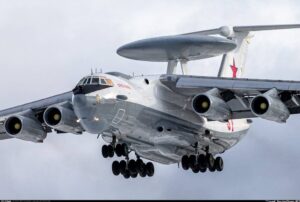 |
| A-50 AEW&C |
The A-50 aircraft has been the subject of much interest in recent news. Since 1983, there have been reports in the West that the Soviet Union had developed a radar aircraft that was equipped with a powerful airborne early warning and control (AEW&C) system, which was a counterpart to NATO’s AWACS. This aircraft is capable of detecting, identifying, and tracing aerial, ground, and naval targets. It is capable of independently directing fighter jets and frontline aviation toward detected hostile targets, in addition to transmitting all the gathered information to command centers.
The detection range of a ground-based radar system is restricted to 200–300 km, contingent upon the terrain. Nevertheless, an AEW&C aircraft that operates from an altitude can observe virtually everything, resulting in a substantial time advantage. This capability enables commanders to make decisions promptly.
A Soviet A-50 was captured on camera by a Norwegian Air Force Lockheed P-3B Orion patrol aircraft over the neutral waters of the Barents Sea on December 4, 1987, marking the first documented confirmation of these allegations. It appears that the Soviet radar aircraft personnel were directed not to evade NATO aircraft. Despite being faster than the turboprop Orion and capable of easily escaping, the jet-powered A-50 did not do so. Consequently, the Western world received the first glimpses of the “Soviet AWACS.”
By that time, these special aircraft, which were built on the Il-76 military transport aircraft platform, had undergone extensive testing in the Soviet Union and were in serial production. The Beriev Design Bureau in Taganrog was responsible for the development of the A-50. Initially, in 1984, the Chkalov Tashkent Aviation Production Association, which was responsible for the production of the Il-76, intended to mass-produce AEW&C A-50 aircraft.
Nevertheless, the Tashkent facility was significantly overburdened by the production of a variety of specialized and transport versions of the Il-76. As a result, a cooperative agreement was reached with the Dimitrov Taganrog Machine-Building Plant, which was already engaged in the production of Tu-142 anti-submarine aircraft. The aircraft was delivered by the Tashkent factory without radar and numerous specialized components. Instead, transportation ports and ballast weights were installed. The future A-50 was transported to Taganrog in this configuration.
Subcontractors supplied the missing components in Taganrog, and the aircraft underwent ground testing of all its systems under electrical power and pressure. Additionally, additional structural elements and interior furnishings were manufactured and installed. Additionally, acceptance and delivery trials, which encompassed the mandatory test flights, were implemented at that location.
The radar operations personnel of the A-50 rotate their seats in the direction of their control panels during patrol flights. The public has access to photographs of this configuration. Nevertheless, the radar system trial stand remained in Tashkent. The task of transporting this 80-ton setup to Taganrog or constructing a new one there was regarded to be too costly and challenging. The serial production of the A-50 continued as intended, despite the obstacles.
In 1985, the Soviet Air Defense Forces deployed the AEW&C aircraft. As anticipated, the integration of the new technology was not without its challenges. In addition to reliability concerns, the aircraft encountered deficiencies in onboard amenities, particularly the restrooms, due to the crew’s size of 15. The flight and radar crews (five pilots and ten radar operators) were also affected by the negative effects of microwave radiation, an unanticipated accumulation of static electricity (which could cause a sudden shock), and noise from operating equipment in the radar compartment. For a period of three years, the Air Defense Forces’ operational personnel, in collaboration with testers from the Air Force Research Institute and the Taganrog Aviation Scientific-Technical Complex (TANTK), conducted final testing, resolved system defects, and optimized its operation in conjunction with interceptor aircraft.
The A-50 was produced until the Soviet Union’s collapse, at which point production ceased due to the exhaustion of inventory of massive assemblies and radar components. The Tashkent aircraft plant was considered unnecessary after Uzbekistan, like other former Soviet republics, became “independent.” In the late 1980s, production issues had already arisen as a result of supply shortages from other countries and challenges in obtaining payment for completed aircraft. The collapse of the USSR resulted in a catastrophe for both the nation and its military, effectively terminating the production of the A-50. The full-scale cooperation between Tashkent and Taganrog for the production of the A-50 was never completely established. A total of 31 A-50 aircraft were manufactured; however, less than one-third have survived to the present day.
In November 2014, the Beriev Aviation Scientific-Technical Complex in Taganrog converted one of the remaining A-50s into a new AEW&C aircraft model, the A-100, which is equipped with more sophisticated modern systems. The A-100 “Premier” airborne laboratory, which is derived from the A-50, performed its inaugural flight on October 26, 2016. The A-100’s maiden flight with an operational onboard radar system took place in 2022. As a result, the prospects for the serial production of these aircraft are uncertain, as Russia presently lacks the technological capabilities that the USSR possessed.
In 2024, Sergei Chemezov, the President of Rostec, the state-owned corporation of Russia, announced that the production of A-50 aircraft would be resumed. He emphasized the aircraft’s critical significance to the Russian military and the potential for export in the announcement. This initiative was partially motivated by the loss of two A-50 aircraft during the conflict in Ukraine.
Official Website of Youtube Channel – Altitude Addicts

